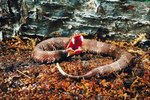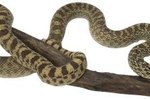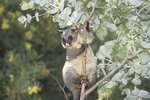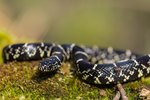
Copperhead snakes (Agkistrodon contortrix) are poisonous reptiles that come from the United States and Mexico, where they are abundant. These sizable snakes retreat into dens for hibernation during the coldest months of the year. Copperhead snakes generally reuse their dens over and over again.
Identifying Copperhead Snakes
Knowing how to identify copperhead snakes can come in handy for identifying their dens. Mature copperhead snakes typically grow to between 24 and 40 inches long, though the boys are bigger than the girls. Copperhead snakes have a basic brown, reddish-brown or beige coloration. Their sturdy physiques feature conspicuous, deep brown crossbands. In line with their handles, copperheads possess heads of that color. Juveniles are markedly lighter than mature specimens and have yellow coloring on the ends of their tails. When copperheads are surrounded by foliage, their bodies make effective camouflage.
Living Environment
Copperhead snakes are frequently seen close to water, specifically ponds, lakes, creeks and rivers. They tend to gravitate to landscapes that are chock-full of vegetation. Copperhead snakes in general are diverse in their living environments, although they often favor woodsy and damp places. Some reside on the outskirts of marshes, while others prefer to stay in rugged fields or in agricultural sites. They frequently take shelter below stones, debris and wood logs. Copperhead snakes are sometimes spotted in suburban sections of urban locales, too. Although they're usually seen on land, they're actually strong swimmers.
Finding Copperhead Dens
When it comes time to hibernate, copperhead snakes usually move to rugged areas close to hills, particularly those that receive ample sunlight for warming. Their dens are often near the borders of marshes, creeks, rivers and lakes. Copperhead snakes frequently hibernate in dens made up of rocks. They also often den inside logs and in holes carved out by mammals. Other typical den spots for these snakes are stone walls, heaps of sawdust, stumps and caves. If you see any of these things, you might be looking at a copperhead winter den. Copperhead snakes generally go into hibernation in the fall, only to come out months later, in early April.
Company in Hibernation
Copperhead snakes don't always hibernate by themselves, although they sometimes do. These often gregarious creatures frequently den with others, sometimes even snakes of different varieties, whether black rat snakes, black racers or rattlers -- think timber rattlesnakes (Crotalus horridus).
References
- Oklahoma Department of Wildlife Conservation: Copperhead
- Massachusetts Division of Fisheries & Wildlife: Copperhead
- Copperheads; Matt Doeden
- Wildlife of Pennsylvania and the Northeast; Charles Fergus
- Savannah River Ecology Laboratory: Copperhead
- Warnell School of Forest Resources: Copperhead
- Smithsonian National Zoological Park: Copperhead Fact Sheet
- North Carolina Cooperative Extension: Copperhead Snake
- IUCN Red List of Threatened Species: Agkistrodon Contortix
Photo Credits
-
Jupiterimages/Photos.com/Getty Images




